Menu
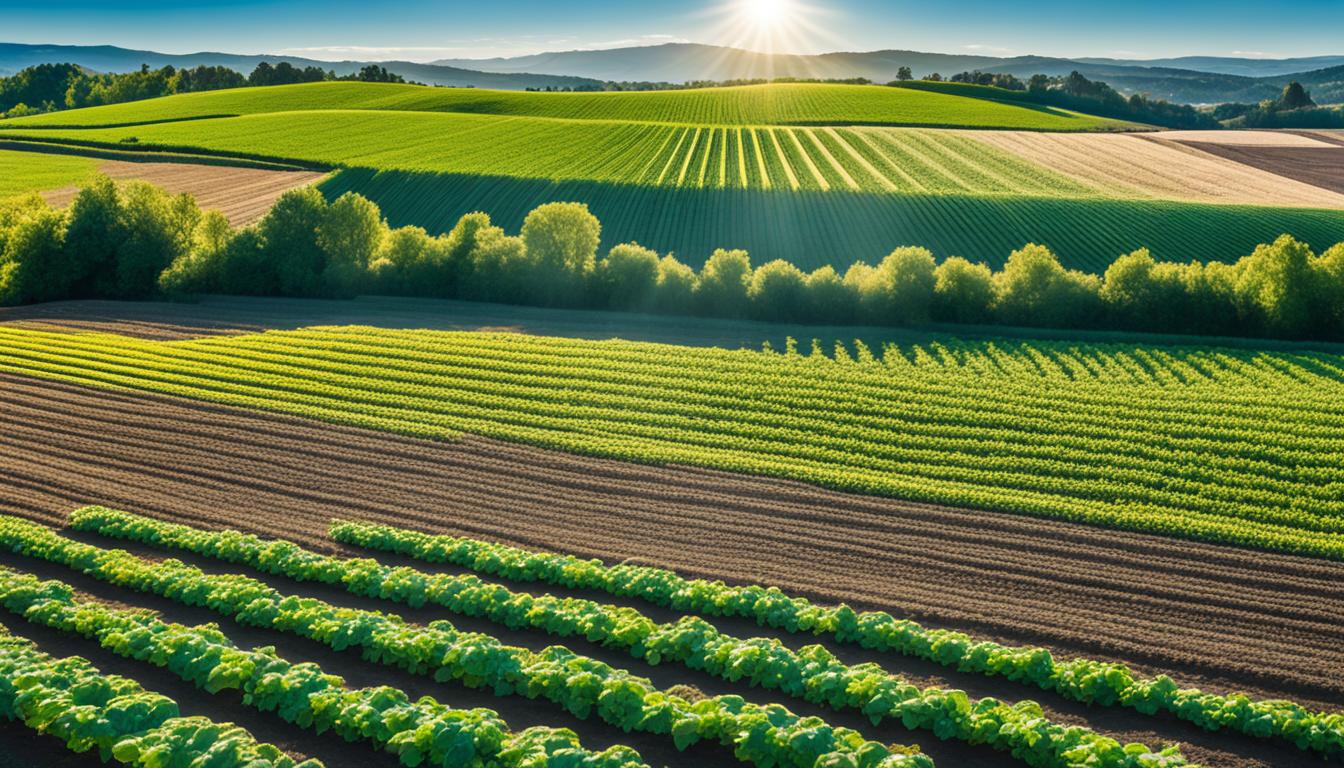
Organic farming is growing across the world, making its mark as the main way to grow things. It’s praised for helping the planet and making money. This method uses things like plant fertilisers and natural ways to control pests. It keeps the land healthy and safe for a long time.
Going organic is about more than just farming. It’s a top choice for saving the Earth, making money, and helping communities. This way of farming is learned from the old days and works with nature, not against it.
It uses smart planting and taking care of the soil to help it stay good. This means less harm to the air and land, without using bad chemicals. By picking organic, you’re helping the Earth and the people who live on it.
Going organic can be a bit tough at first. You have to learn new stuff, choose the right plants, and plan well. But the good part is that the land and the people will be way better off in the end.
Organic farming is a way of farming that uses natural methods and avoids man-made chemicals. Farmers work to keep the soil healthy, support natural balance, and protect different kinds of plants and animals. It’s an ancient way of farming, using practices that have been around for many years.
Organic farmers don’t use artificial fertilisers or pesticides. They focus on nourishing the soil with natural materials like manure and compost. This method has become very popular. In the United States, sales of organic food grew to almost $48 billion in 2019. Europe saw even more organic food sales, with over $52 billion (€45 billion) in the same year.
Although organic crops yield about 25 percent less, they aim at caring for the environment. The price of organic food can vary a lot. Sometimes, it’s just a little more expensive than regular food. At times, it can be much more costly.
| Year | Organic Food Sales (US) | Organic Food Sales (Europe) |
|---|---|---|
| 2008 | $20.39 billion | — |
| 2019 | $47.9 billion | $52 billion |
Crop rotation is fundamental in organic farming. It keeps the soil rich and fights off pests and diseases. Biodynamic farming, which is a part of organic farming, goes further. It uses the stars and special composts to enhance biodiversity and balance in nature.
Agencies like BioGro NZ set many standards for organic farming. They focus on animal welfare, fighting climate change, and saving different plants and animals. These standards make sure that organic products are really what they claim to be. For pest control, organic farming uses friendly insects, selective plant breeding, and natural pesticide sources.
Organically grown food is better for you and the planet. It helps keep the environment healthy. It also supports farming that lasts for a long time.
Organic farming helps the planet in big ways. It avoids using harmful chemicals. This keeps the soil and water clean. Also, by not using chemicals, the food has fewer bad substances. This makes the whole environment healthier.
By farming in a natural way, we fight climate change. We also protect the land from getting worn out. This way of farming is good for the earth’s future.
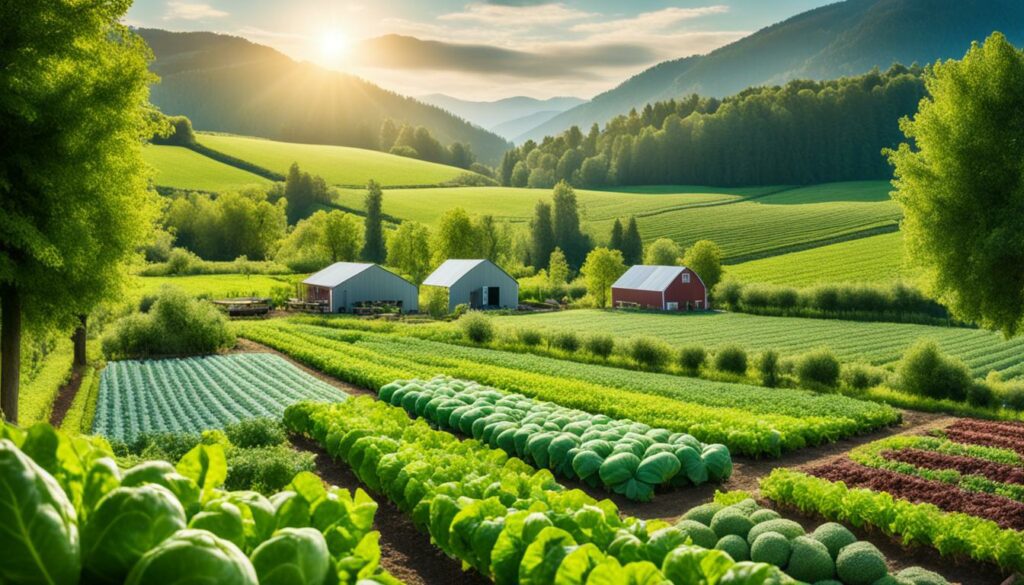
Choosing organic food can be good for the economy. Yes, it may cost a little more at first. But it helps in the long run.
Places like Australia have seen this in action. Their rivers are getting cleaner because of organic farming. Also, buying organic food helps local farmers. It reduces pollution caused by shipping food long distances.
Eating organic food is really good for your health. It has more of the good stuff your body needs. For example, organic meat has more omega-3. This is great for your heart.
There are also fewer bad chemicals in organic food. This lowers the risk for people who eat it. Although both organic and not-organic food can have germs, organic food is cleaner. This is because it doesn’t have artificial chemicals.
| Benefit | Organic Produce | Conventionally Grown Produce |
|---|---|---|
| Nutrient Levels | Higher in certain nutrients | Moderate nutrients |
| Omega-3 Fatty Acids | Up to 50% higher in meat and dairy | Lower levels |
| Pesticide Residue | Lower levels | Higher levels |
| Cadmium in Grains | Significantly lower | Higher |
| Economic Impact | Supports local economies | Less direct impact |
In the world of organic farming, keeping the soil healthy is key. By doing things like composting, planting cover crops, and using no-till farming, farmers make the earth richer. This helps crops grow well and stops the land from washing away. These methods help the environment and keep farms going strong for years.
Organic soils are packed with more organic matter than others. They have about 8.33 percent, while non-organic soils have 7.37 percent. This difference is vital for making the soil rich, which is great for growing healthy crops.
Things like composting and planting cover crops do a lot for the soil. Composting adds nutrients and makes the soil better. It even helps helpful microbes thrive. Also, soybean plants in organic fields can make more nitrogen-fixing nodules. This is important because it feeds the soil, helping crops grow strong.
Stopping soil from eroding is very important. Actions like no-till farming and using cover crops can do this. Study shows that areas where no-till farming and strip-tilling is used make less nitrous oxide. This is good for the planet.
Planting cover crops like hairy vetch can make enough nitrogen for corn by itself. A study found that when vetch biomass was high, the corn yield was also high. This not only keeps the soil from eroding but also makes it rich in nutrients.
| Soil Type | Organic Matter Content (%) | Humified Carbon (%) | No-Till N2O Emissions (kg/ha) |
|---|---|---|---|
| Organically Managed | 8.33 | 4.1 | 0.9 |
| Conventionally Managed | 7.37 | 2.85 | 2.1 |
To sum up, using organic methods like composting, cover crops, and no-till farming does a lot. It makes the soil rich. It also stops the soil from washing away. This is important for a farming that lasts.
Organic farming uses various techniques to support sustainable agriculture and keep the environment healthy. It focuses on better soil, natural pest control, and maintaining a farm’s harmony.
Crop rotation is key in organic farming. It breaks pest and disease patterns, adds to soil quality, and boosts farm biodiversity. Farmers change the type of crops they plant in the same field to fight pests and keep the soil filled with nutrients.
Cover crops help keep the soil healthy between main crop seasons. They stop soil from washing away, add nutrients to the ground, and slow down weed growth. Legumes and grasses are popular because they help the soil and the environment.
Composting turns trash into treasure for the soil. It makes the earth healthier, meeting the goal of having 3% organic matter. This waste-reducing process also strengthens soil, making it hold water better and helping roots grow stronger.
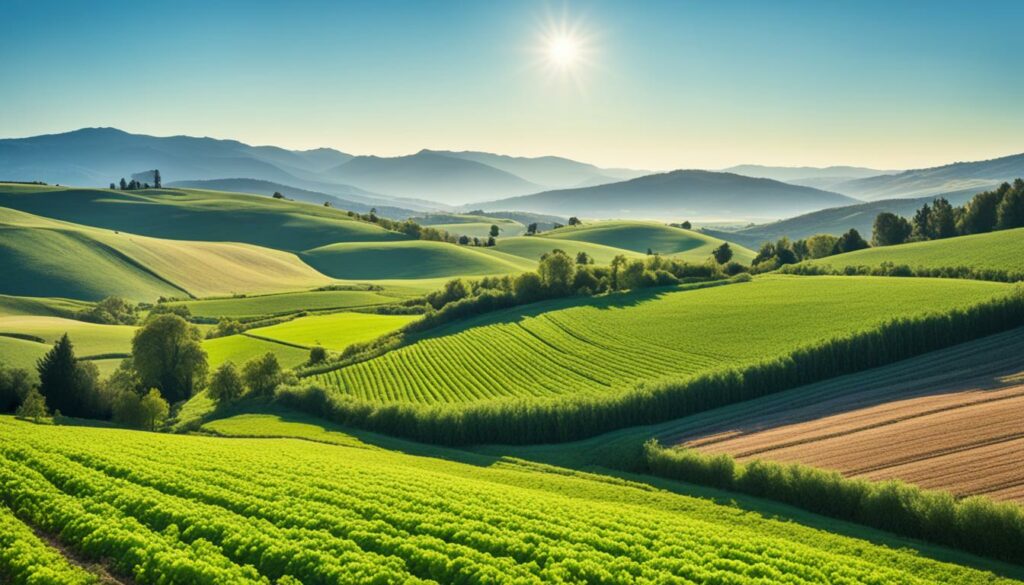
No-till farming works by not ploughing the soil. This way, the soil stays firm, stops water loss, and keeps more carbon in the ground. Healthy soil allows for better farming practices and a happier planet.
Organic farmers fight pests naturally with integrated pest management (IPM). They encourage helpful bugs, use strong plants, and rotate the crops. This way, they protect their farms without harmful chemicals, following strict organic rules.
| Method | Benefits |
|---|---|
| Crop Rotation | Increases soil organic matter, disrupts pest cycles, enhances biodiversity |
| Cover Crops | Prevents erosion, improves soil fertility, suppresses weeds |
| Composting | Recycles waste, enriches soil, promotes better water retention |
| No-Till Farming | Reduces erosion, conserves moisture, maintains soil structure |
| Integrated Pest Management | Natural pest control, reduces need for synthetic pesticides, promotes ecosystem health |
Crop rotation is a key part of organic farming. It helps keep soil healthy and supports long-term farming. Changing the crops in each field boosts soil nutrients, fights pests, and increases plant variety. This method works like nature does, making farms stronger and less reliant on chemicals.
Rotating crops has many advantages. It helps keep or make the soil better. Growing different crops in cycles stops pests and diseases without using chemicals. Crop rotation also improves how the soil is structured and increases tiny life forms, which is good for the farm’s health.
Roughly 80% of the U.S. corn crop grows in rotations with soybeans or other crops. This shows how popular and effective crop rotation is. By doing this, farmers can keep their soil healthy and productive.
To rotate crops well, farmers must plan carefully and know about growing many types of plants together. They start by setting goals for their fields, like giving the soil more nutrients or keeping away certain pests. Then, they choose a variety of crops and make a map to plan where each will grow.
Choosing the right cover crops is important, too. They might pick ones that add nitrogen to the soil, help insects, or control weeds. For some crops that come back every year, like fruit trees, farmers might grow different plants between the rows. This adds even more variety and helps fight pests. Being flexible in their plans lets farmers deal with changes in the weather or the market while still keeping the soil and the business healthy.
| Crop Type | Primary Benefits | Example Crops |
|---|---|---|
| Grasses | Improves soil structure, prevents erosion | Corn, Barley, Wheat |
| Legumes | Nitrogen fixation, enriches soil nutrients | Peas, Beans, Clover |
| Brassicas | Pest control, nutrient recycling | Broccoli, Cabbage, Kale |
Mixing different types of crops makes sure the soil gets what it needs. This is vital for farming that can last. By using these methods, organic farmers build farming systems that are lively, strong, and good for the earth over a long time.
Composting is key in organic farming, turning waste into nutrients for the soil. This helps make the soil better. It also captures carbon, making farming more eco-friendly.
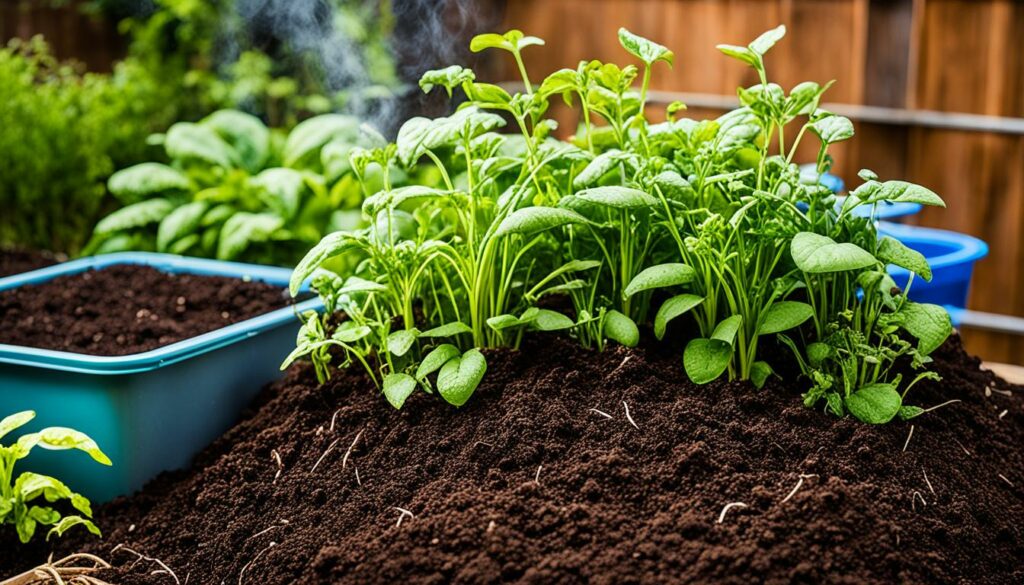
Composting boosts soil life, making it better at fighting plant diseases. It makes the soil more able to hold water and stops heavy metals from hurting plants. This helps organic farmers keep the soil healthy and their crops strong.
Compost also helps soil hold more carbon and improves the food for grazing animals. That’s vital for healthy farming and the environment.
To compost well, mix green and brown materials right and keep the pile damp and airy. This setup heats up to 130-150°F and works for weeks. There are many ways to compost, like using piles, windrows, or special containers.
For top-notch compost, aim for a certain mix of greens and browns and keep it warm, between 131°F and 170°F. This recipe ensures good compost in the end.
Integrated Pest Management (IPM) is a smart way to deal with pests in organic farming. It focuses on stopping pest problems in the first place using natural ways. This approach fits well with permaculture by keeping nature in balance, using friendly bugs, and only using chemicals when nothing else works.
Preventing pests is the heart of IPM. Farmers check their crops often to catch any pest issues early. They use tools like sweep nets and traps to find pests fast. Knowing which pests are around helps plan how to keep their numbers low. This involves growing different plants together and changing where crops are planted, which keeps the soil and plants healthy while making it hard for pests to spread.
Using nature’s own methods to control pests is key in IPM. It means using good bugs to eat the bad ones. For example, ladybirds and wasps help keep pest numbers down. There are also special organic pesticides that can be used. These don’t harm the environment but can still target specific pests. All of this is approved in organic farming.
Mechanical and physical ways to keep the pests away are part of IPM, too. This includes traps and barriers to stop pests getting to plants. Taking pests off plants by hand and using temperature to control them can also work. Keeping good notes and following the rules for organic farming make IPM a solid plan.
IPM helps organic farms use fewer chemicals. This leads to farming that is better for the earth and follows permaculture’s way of working with nature.
Biodynamic farming is a type of advanced organic farming. It brilliantly combines ethical practices with a deep understanding of nature’s interactions. It goes beyond traditional organic methods, seeing the farm as an ecosystem that can sustain itself.

It is based on the ideas of Rudolf Steiner. It focuses on agriculture being sustainable through healthy soil, diverse plants, and cosmic influences on growth. There are over 5,000 certified farms worldwide, on over 400,000 acres, in 60 countries. The farms must follow certain rules, like growing over 50% of their livestock’s food on-site and giving at least 10% of their land to wildlife.
In biodynamic farming, special preparations and calendars are used to plant crops at the right time. These consider the earth’s rhythms and the positions of the sun, moon, stars, and planets. Important preparations include:
Biodynamic composting is vital too. It uses special preparations from yarrow, chamomile, stinging nettle, oak bark, dandelion, and valerian. These help healthier soil, store more carbon, and support life in the soil. They make good farming even better, help fight pollution, and lessen the harm from severe weather.
This farming doesn’t rely much on things from outside. It tries to use what it has, like its animals, compost, and certain plants, to feed the soil. This leads to soil that’s full of nutrients and carbon, and that can keep more water. Tests show that biodynamic farming can hold 40% more water than usual farming.
For those in biodynamic farming, there’s plenty of help. The Biodynamic Association, started in 1938, provides learning, research, and meetings. The certification is managed by Demeter International and Demeter USA, making sure the rules are the same worldwide.
| Key Practice | Function |
|---|---|
| Biodynamic Compost | Increases soil life and organic matter, sequesters carbon |
| Horn Manure Preparation | Enhances soil life and soil-plant relationship |
| Horn Silica Preparation | Strengthens photosynthesis and plant immunity |
| Horsetail Tea Preparation | Prevents fungal diseases, balances water content |
Biodynamic farming is respected for its strict rules and innovative techniques. It helps nature and farming work well together.
No-till farming is key in organic methods, giving many soil benefits and better farm efficiency. It keeps a diverse and healthy soil ecosystem by lessening disturbance. Tools like the roller crimper show excellent results with this method.
No-till farming is superb for soil health. Old ways of tilling cause soil disruption and erosion. On the other hand, organic no-till ways, using tools like the roller crimper, cut down erosion.
They make soil better for microorganisms by adding organic matter. This also helps the soil hold more water, which is great for plants during dry spells. No-till farming also keeps the homes of many soil creatures, boosting farm biodiversity.
| Advantages | Details |
|---|---|
| Soil Erosion Reduction | No-till methods, particularly with the roller crimper, significantly decrease soil erosion. |
| Improved Soil Health | Organic matter addition from no-tillage enhances soil quality and productivity. |
| Moisture Retention | No-till farming retains soil moisture better due to the absence of disruption. |
| Biodiversity Increase | Preserved soil habitats encourage more diverse ecosystems. |
| Weed Pressure Reduction | Techniques like the roller crimper help to alleviate weed pressure on crops. |
To start no-till farming, you need to understand it and stop using traditional tilling. It often means using special equipment like advanced seeders and roller crimpers. These allow for faster sowing without disturbing the soil much.
Such machines cut down on fuel use. The U.S. Department of Agriculture says you can use between 2 to 6 gallons less per acre. Yes, these tools can cost a bit upfront, but they save money and time in the long run.
No-till methods are part of a plan to control weeds without using chemicals. This helps nature and people. The USDA says more farmers are doing no-till for economic and environmental reasons.
Advanced tools like EOSDA Crop Monitoring are a big help for no-till farms. They give info from satellites on things like crops and soil. This lets farmers plan better, save on resources, and protect the environment.
Cover crops are key in organic farming, boosting soil health and farm longevity. They help in no-till growing and cut down on soil erosion. This keeps nutrients where they are needed.
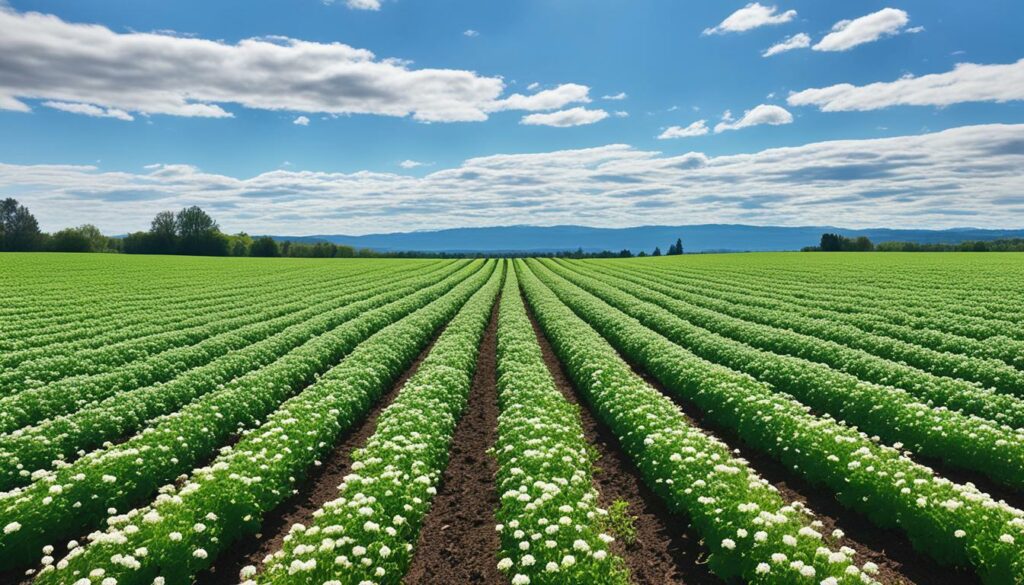
Different cover crops bring varied benefits to the soil. Some common ones used in organic farming are:
Choosing the right cover crop can improve the soil based on local needs. This also helps biodiversity in the area.
Cover crops don’t just boost the soil. They also help in pest and disease control by enhancing soil life. This makes farming more sustainable. They improve how soil retains water and copes with bad weather.
One big plus is how they increase soil nitrogen, which is great for other plants. And seeding cover crops with drones makes planting easier for farmers.
While cover crops are great, using them faces some challenges like planting and fighting weeds. Yet, the benefits for the land and crops are really worth it.
For more on cover crops’ benefits and types, check this informative resource.
Polyculture is a smart way to farm. It mixes many types of crops in the same area. This mix is like nature’s way, boosting variety and making the farm stronger. Unlike growing just one crop, having many types together helps the soil and the plants thrive.
Polyculture is planting different crops together. It’s the opposite of using only one crop on a big piece of land. You’ll see various planting methods like growing different crops at different times in the same spot, mixing them, or using a cover crop. These methods make the best use of the land, keeping it healthy.
Growing different crops together saves resources. For example, some plants help each other by improving the way they use water and air, and by how they catch sunlight. This makes the farm produce well in a natural and balanced way.
Setting up a polyculture farm needs careful thought and understanding of what works best together. Here’s how to do it:
Polyculture is great for organic farms. It boosts plant variety, keeps the soil in top shape, and helps farming last without hurting the earth. Doing polyculture the right way means using resources well and making a farm that’s strong against tough times.
Organic farming focuses on ethical livestock care. This includes making animal welfare a top priority. It uses sustainable methods to keep animals healthy and protect the environment. Rotational grazing is key. It helps maintain lush pastures and save natural resources.
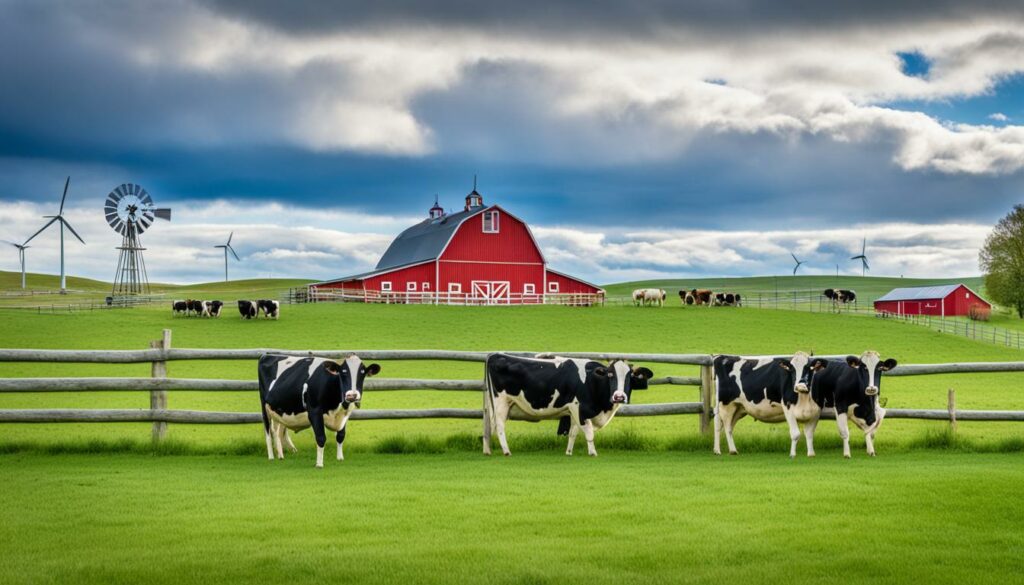
Organic livestock management follows strict rules for animal welfare. Farmers must meet USDA Organic certification standards. These rules protect the environment and biodiversity by not using certain chemicals. They also help in sustainable farming.
Organic feed and land are musts for these animals. This makes livestock healthier and farm produce better. Organic farmers often choose hardy heritage breeds for outdoor life. This is unlike factory farming’s harmful impact on the environment.
Rotational grazing is vital in organic farming. It benefits animals and the land. This method moves animals between pastures to prevent damage. It also increases soil health. It’s good for the earth and farming.
This method is great for the environment. It helps in the fight against climate change. Farms using rotational grazing have healthy soils and more wildlife. Animal waste can also help as a natural fertiliser, boosting biodiversity.
| Aspect | Conventional Farming | Organic Farming |
|---|---|---|
| Animal Welfare | Often compromised, use of antibiotics and growth hormones | Strict guidelines, no antibiotics or growth hormones |
| Feed Source | Non-organic, often GMO | 100% certified organic |
| Land Use | May lead to soil erosion and emissions | Utilises marginal land, prevents overgrazing |
| Environmental Impact | High, contributing to climate change | Low, sequesters carbon and supports biodiversity |
Organic farming has many benefits, but also faces several key hurdles. To make it a successful, long-lasting choice, we must overcome these challenges. Some of the issues are money problems, accessing markets, and a lack of knowledge.
One big issue for organic farmers is finding a balance between making money and taking care of the environment. For many, the cost of getting certified is a huge burden. This cost hits over half of Black, Indigenous, and People of Colour (BIPOC) farmers. Although the Organic Certification Cost Share Program (OCCSP) helps, it’s not enough.
Pests and weeds are a big headache in organic farming. Without chemicals to fight them off, there’s often less produce. This method also usually needs more space to grow the same amount as non-organic farms. This makes it very important for organic farmers to keep their soil healthy and find alternative ways to control pests.
Organic food sales have been rising sharply, reaching over $56 billion in 2020. This shows that people are more interested in organic products. Organic farmers can benefit from this by growing their market share.
Helping farmers learn more is vital for tackling knowledge gaps. Thanks to the 2018 Farm Bill, the Organic Agriculture Research and Extension Initiative (OREI) has steady funding. This supports organic research, like improving plant breeding and seeds. Working together, farmers, scientists, and policymakers can find and share new organic farming methods.
Dealing with pests organically needs a full approach. Integrated Pest Management (IPM) uses methods like natural predators and traps. It’s effective in reducing pest problems. Additionally, organic farmers are much more likely to use cover crops, showing a strong commitment to protecting the environment.
| Challenge | Statistic | Solution |
|---|---|---|
| Certification Costs | 31% of all respondents | OCCSP and Farm Bill opportunities |
| Pest Control | More prone without synthetic inputs | IPM strategies and natural solutions |
| Land Requirement | More land needed compared to conventional farming | Utilising cover crops and crop rotation |
| Knowledge Gaps | Ongoing challenge | Educational initiatives and community support |
To really win over the challenges, a combined strategy is essential. This involves applying organic farming techniques and caring for the environment. Doing this sets a path for a better, more sustainable future.
Starting with organic farming is a great way to help the environment. Even though it’s only a small part of agriculture in most places, its impact is huge. A small change in organic farming can really shake up the market because of its smaller scale. Despite its limits, organic farming has shown it can weather tough conditions like drought.
The government steps in to help this sector with subsidies. These can be direct payments or support for things like education and marketing. Farmers might choose organic farming because they can charge more for their products. This helps their income and makes food supplies stronger. There are also social perks, like upholding old farming values and boosting community health.
Using methods like crop rotation and composting brings big wins for the planet and our health. Organic farming avoids harmful pesticides and fertilisers. This keeps the soil healthy, protects plant and animal life, and makes our food more nutritious. Plus, it pulls about 3500 pounds of CO2 out of the air every year, helping to fight climate change. People want more organic food, showing a concern for health, the planet, and food safety. This trend highlights the appeal and need for sustainable farming over time.
Organic farming is a system that avoids synthetic stuff like fertilisers and pesticides. Instead, it uses natural methods. This way, it keeps the soil healthy and the environment balanced. It also helps protect different plant and animal species.
It’s about keeping the soil healthy by using compost, cover crops, and changing what you plant. This approach also supports a balance in nature and protects the variety of life on our planet. Biodynamic farming adds special beliefs and actions to this.
Organic food is good for the Earth, your pocket, and your health. It makes the soil better and fights against climate change. This type of farming keeps harmful chemicals out of your food.
By adding things like compost and using certain plants, organic farming makes soil healthy. This means it can fight off pests and diseases better. It also survives droughts well.
No-till farming and using cover and providing a protective layer to the soil stops it from washing or blowing away. These methods keep the soil strong against the weather.
Organic farming uses several methods to keep the soil and plants good. These include changing what you grow each year, adding covers, making compost, and being careful with how you deal with pests. It’s all about working with nature.
Rotating crops makes the soil richer and healthier. It also confuses bugs and germs that can hurt the plants. This helps you not need as many chemicals for your fields.
To rotate crops, you plan which plants will come next in your field. This keeps the soil in good condition and helps to control pests naturally.
Composting turns old plant bits into food for your soil. It makes the ground better for growing things and helps fight climate change.
To make good compost, mix a lot of different plant parts with water and air. This helps them break down into a good soil booster.
IPM is a smart way of keeping bad bugs off your plants. It uses many tricks, like having different plants together and welcoming good bugs, but it only uses chemicals as a last resort.
Biodynamic farming is like organic farming, but it uses more special ways based on nature’s rhythms. This includes using special preparations and following the stars when planting. These make the farm even more in tune with nature.
No-till farming keeps the ground healthy and alive, as it doesn’t disturb the soil. This helps the soil to hold more water and nutrients for the plants.
No-till farming is about not digging your field up before you plant. This way, the soil stays in good shape. You can plant directly into it and use cover crops to help.
Cover crops are plants you grow just to protect the soil. They stop weeds, keep the soil rich, and give food to the next crop. Different cover crops do different jobs, depending on your land.
Polyculture is when you grow many kinds of plants together, like a natural forest. It makes the land stronger and more productive. This way of farming works with nature to create a balanced farm.
Putting different crops together in the right way makes a healthy farm. You need to choose what to grow and where carefully. This helps all the plants and animals on your farm to thrive.
Looking after animals well is key in organic farming. Happy animals mean a healthy farm. Things like letting them eat the right grass at the right time also keep the farm soil strong.
Going organic can be tough because it’s not just about what you do, but how you think. It can cost more, and you need to know a lot. Getting your food to the market can be hard. But, working together and learning new things can help.